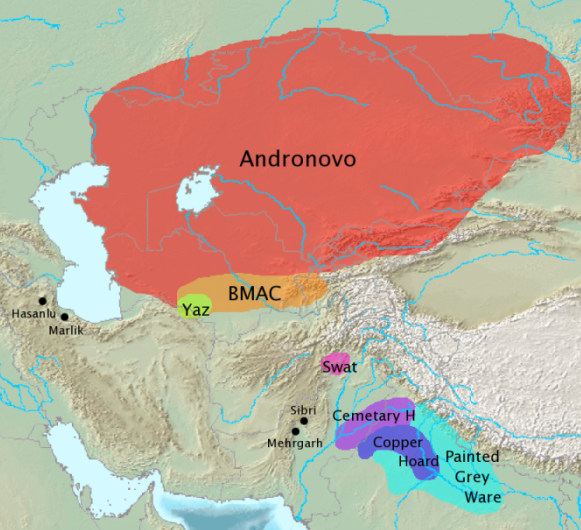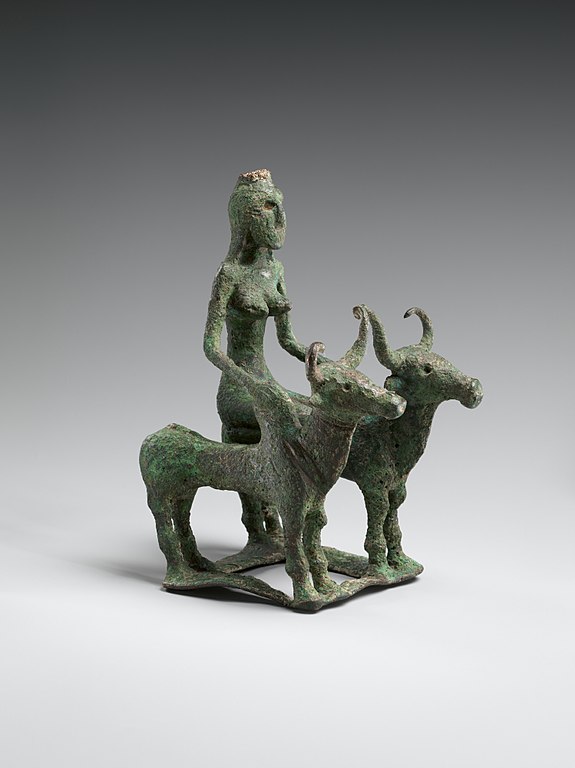
| OCHERE COLOURED POTTERY CULTURE
Archaeological cultures associated with Indo-Iranian migrations (after EIEC) The Andronovo, BMAC and Yaz cultures have often been associated with Indo-Iranian migrations. The GGC, Cemetery H, Copper Hoard and PGW cultures are candidates for cultures associated with Indo-Aryan movements.
The Ochre Coloured Pottery culture (OCP) is a 4th millennium BC to 2nd millennium BC Bronze Age culture of the Indo-Gangetic Plain, extending from eastern Punjab to northeastern Rajasthan and western Uttar Pradesh. It is considered a candidate for association with the early Indo-Aryan or Vedic culture.
The pottery had a red slip but gave off an ochre color on the fingers of archaeologists who excavated it, hence the name. It was sometimes decorated with black painted bands and incised patterns. It is often found in association with copper hoards, which are assemblages of copper weapons and other artifacts such as anthropomorphic figures. OCP culture was rural and agricultural, characterized by cultivation of rice, barley, and legumes, and domestication of cattle, sheep, goats, pigs, horses, and dogs. Most sites were small villages in size, but densely distributed. Houses were typically made of wattle-and-daub. Other artifacts include animal and human figurines, and ornaments made of copper and terracotta.
OCP culture was a contemporary neighbor to Harappan civilization, and between 2500 BC and 2000 BC, the people of Upper Ganga valley were using Indus script. While the eastern OCP did not use Indus script, the whole of OCP had nearly the same material culture and likely spoke the same language throughout its expanse. The OCP marked the last stage of the North Indian Bronze Age and was succeeded by the Iron Age black and red ware culture and the Painted Grey Ware culture.
Geography :
Woman Riding Two Bulls (bronze), from Kausambi, c. 2000 - 1750 BCE Early specimens of the characteristic ceramics found near Jodhpura, Rajasthan, date from the 3rd millennium (this Jodhpura is located in the district of Jaipur and should not be confused with the city of Jodhpur). Several sites of culture flourish along the banks of Sahibi River and its tributaries such as Krishnavati river and Soti river, all originating from the Aravalli range and flowing from south to north-east direction towards Yamuna before disappearing in Mahendragarh district of Haryana.
The culture reached the Gangetic plain in the early 2nd millennium. Recently, the Archaeological Survey of India discovered copper axes and some pieces of pottery in its excavation at the Saharanpur district of Uttar Pradesh. The Ochre Coloured Pottery culture has the potential to be called a proper civilisation (e.g., the North Indian Ochre civilisation) like the Harappan civilisation, but is termed only as a culture pending further discoveries.
Copper
hoards :
Characteristic hoard artefacts from southern Haryana/northern Rajasthan include flat axes (celts), harpoons, double axes, and antenna-hilted swords. The doab has a related repertory. Artefacts from the Chota Nagpur area are very different; they seem to resemble ingots and are votive in character.
The raw material may have been derived from a variety of sources in Rajasthan (Khetri), Bihar, West Bengal, Odisha (especially Singhbhum), and Madhya Pradesh (Malanjkhand).
Source :
https://en.wikipedia.org/wiki/ |

